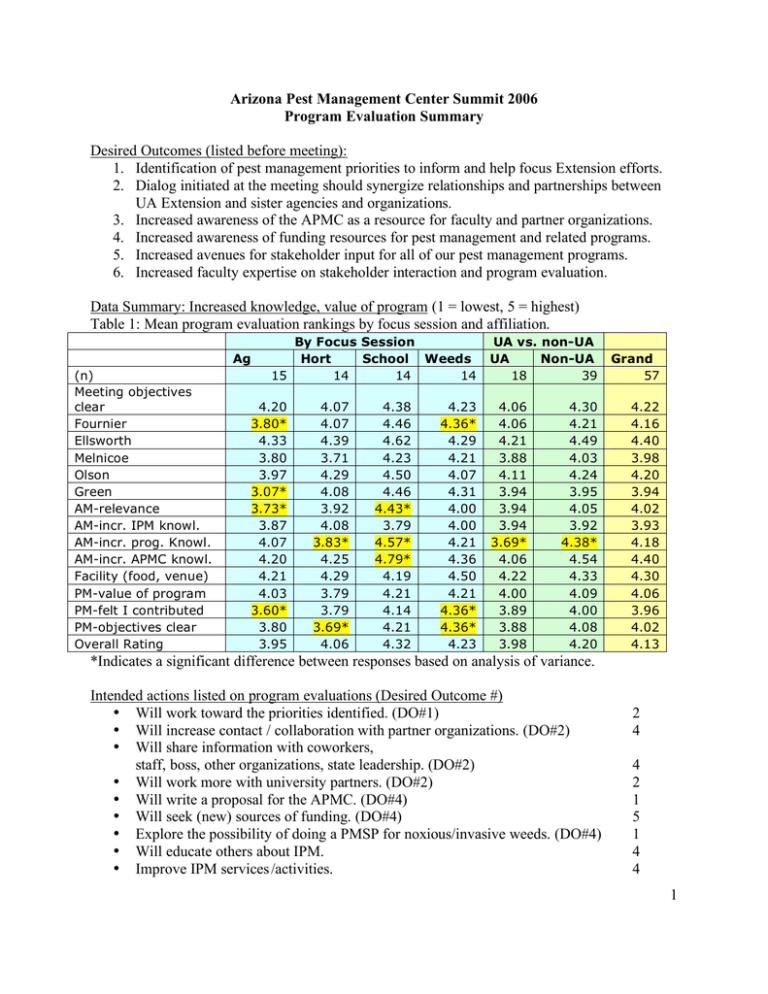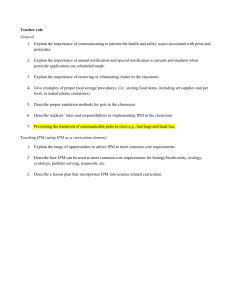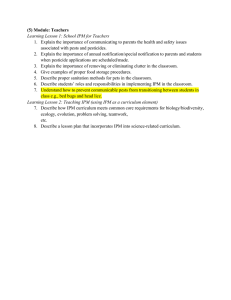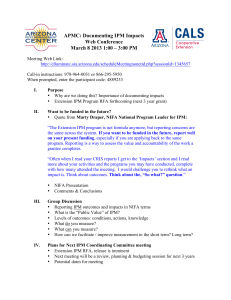Desired Outcomes (listed before meeting): Arizona Pest Management Center Summit 2006
advertisement

Arizona Pest Management Center Summit 2006 Program Evaluation Summary Desired Outcomes (listed before meeting): 1. Identification of pest management priorities to inform and help focus Extension efforts. 2. Dialog initiated at the meeting should synergize relationships and partnerships between UA Extension and sister agencies and organizations. 3. Increased awareness of the APMC as a resource for faculty and partner organizations. 4. Increased awareness of funding resources for pest management and related programs. 5. Increased avenues for stakeholder input for all of our pest management programs. 6. Increased faculty expertise on stakeholder interaction and program evaluation. Data Summary: Increased knowledge, value of program (1 = lowest, 5 = highest) Table 1: Mean program evaluation rankings by focus session and affiliation. Ag (n) Meeting objectives clear Fournier Ellsworth Melnicoe Olson Green AM-relevance AM-incr. IPM knowl. AM-incr. prog. Knowl. AM-incr. APMC knowl. Facility (food, venue) PM-value of program PM-felt I contributed PM-objectives clear Overall Rating By Focus Session Hort School Weeds 15 14 14 14 4.20 3.80* 4.33 3.80 3.97 3.07* 3.73* 3.87 4.07 4.20 4.21 4.03 3.60* 3.80 3.95 4.07 4.07 4.39 3.71 4.29 4.08 3.92 4.08 3.83* 4.25 4.29 3.79 3.79 3.69* 4.06 4.38 4.46 4.62 4.23 4.50 4.46 4.43* 3.79 4.57* 4.79* 4.19 4.21 4.14 4.21 4.32 4.23 4.36* 4.29 4.21 4.07 4.31 4.00 4.00 4.21 4.36 4.50 4.21 4.36* 4.36* 4.23 UA vs. non-UA UA Non-UA 18 39 4.06 4.06 4.21 3.88 4.11 3.94 3.94 3.94 3.69* 4.06 4.22 4.00 3.89 3.88 3.98 4.30 4.21 4.49 4.03 4.24 3.95 4.05 3.92 4.38* 4.54 4.33 4.09 4.00 4.08 4.20 Grand 57 4.22 4.16 4.40 3.98 4.20 3.94 4.02 3.93 4.18 4.40 4.30 4.06 3.96 4.02 4.13 *Indicates a significant difference between responses based on analysis of variance. Intended actions listed on program evaluations (Desired Outcome #) • Will work toward the priorities identified. (DO#1) • Will increase contact / collaboration with partner organizations. (DO#2) • Will share information with coworkers, staff, boss, other organizations, state leadership. (DO#2) • Will work more with university partners. (DO#2) • Will write a proposal for the APMC. (DO#4) • Will seek (new) sources of funding. (DO#4) • Explore the possibility of doing a PMSP for noxious/invasive weeds. (DO#4) • Will educate others about IPM. • Improve IPM services /activities. 2 4 4 2 1 5 1 4 4 1 Additional outcomes (word of mouth) • Request to conduct a citrus priority-setting session. (DO#6) • Request to conduct a turf priority-setting session. (DO#6) • Contacted about a potential role for the APMC to help coordinate efforts to apply for federal funding for noxious and invasive weed management. (DO#3,4) • An attendee from the Hopi Environmental Protection Office made contacts at the meeting that led to the development of a pilot IPM program for a local hospital. • An attendee from the City of Phoenix met on June 12 with city officials and pest management contractors to develop IPM pilot programs for 3 municipal facilities. • One of the identified priorities in the school IPM session was a need to develop consistent "standards" for a school IPM service. Two pest management companies that participated in the meeting are moving forward to develop a model for a standard school IPM service. Dawn Gouge will apply for WIPMC funds to pilot test components of IPM in schools “toolbox.” • A representative from one of the tribes approached one of our faculty IPM team leaders to offer support when faculty apply for program grant funds. Suggestions for improvement of focus sessions • Provide more time for priority setting. • Provide more direction for focus sessions • Break into smaller groups, smaller rooms • Plan a follow-up meeting to discuss how 2006 priorities are addressed • Provide examples of priorities to clarify the process • Focus sessions should “focus” on one or two ideas • Do focus sessions in the AM • Some ideas were “lost.” Need a system for retaining ideas. • Organize so that participants can attend more than one focus session • Need trained facilitators • Broaden participation or invite specific groups not represented • No suggestions. Good job. 5 3 2 1 1 1 1 1 1 1 1 5 Additional Comments Facilities • Great food. • Room was too hot. • Good venue for IPM. Meeting participation • Good participation from the community; “very impressive!” • Wish [my particular interest group] had been better represented. Meeting content, topics, speakers • Too much time spent on funding issues. • “It would have been informative to see the entire breakdown for funding 4 5 1 1 1 3 2 (for UA programs).” • Too much time spent on IPM definitions. • Good opportunity for stakeholders to have input. • Eliminate the AM session. • Recommend more focused meetings on each of the IPM areas. • A challenge to appeal to such a variety of participants • Morning presentations were all excellent. • Olson’s talk was fun • Green presentation: “I was offended by his lack of science and not telling all of the story.” • Green presentation: “Some misleading statements put the ‘edge’ in IPM.” • Green presentation: “He needs to have his slides peer reviewed by a panel of scientists. Much of it was scientifically invalid or questionable.” • Focus sessions seemed successful General • Interesting mix of attendees. • Great meeting attendance. • Well run / well organized. • “Great job” etc. • “A good start.” • “Time well Spent” • Hold these kinds of meetings more often. • “Why don’t Extension groups talk to each other? Between states, not just within focus groups (FCS, 4-H, Ag, specialists, etc.) Breakdown bureaucratic boundaries.” • “Pesticide control [reps?] don’t understand the tribal programs.” 1 1 1 1 1 1 1 1 1 1 1 1 1 1 4 4 1 1 1 1 1 Other observations and suggestions of speakers/facilitators • • • • • We might have had a better “mix” of morning presenters, representing other IPM disciplines (weed science, plant pathology, etc.) A bit more time (perhaps 20-30 minutes more) for the priority-setting activity would have allowed more time to discuss needs and solutions while still keeping an urgent focus. Need better representation from campus-based researchers. Perhaps the morning program was too long—too many speakers. People have more energy in the morning. If we could get to the priorities quicker, while still providing enough context, that would be beneficial. We should do sign-in sheets for the breakout sessions next time. This time we generated participant lists for each session based on the sign-in sheets for the overall meeting plus knowing which session people had RSVPed for. This didn’t account for people who left the meeting early or switched to a different session. 3




